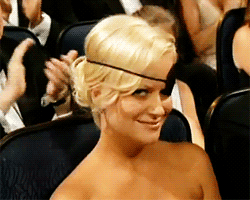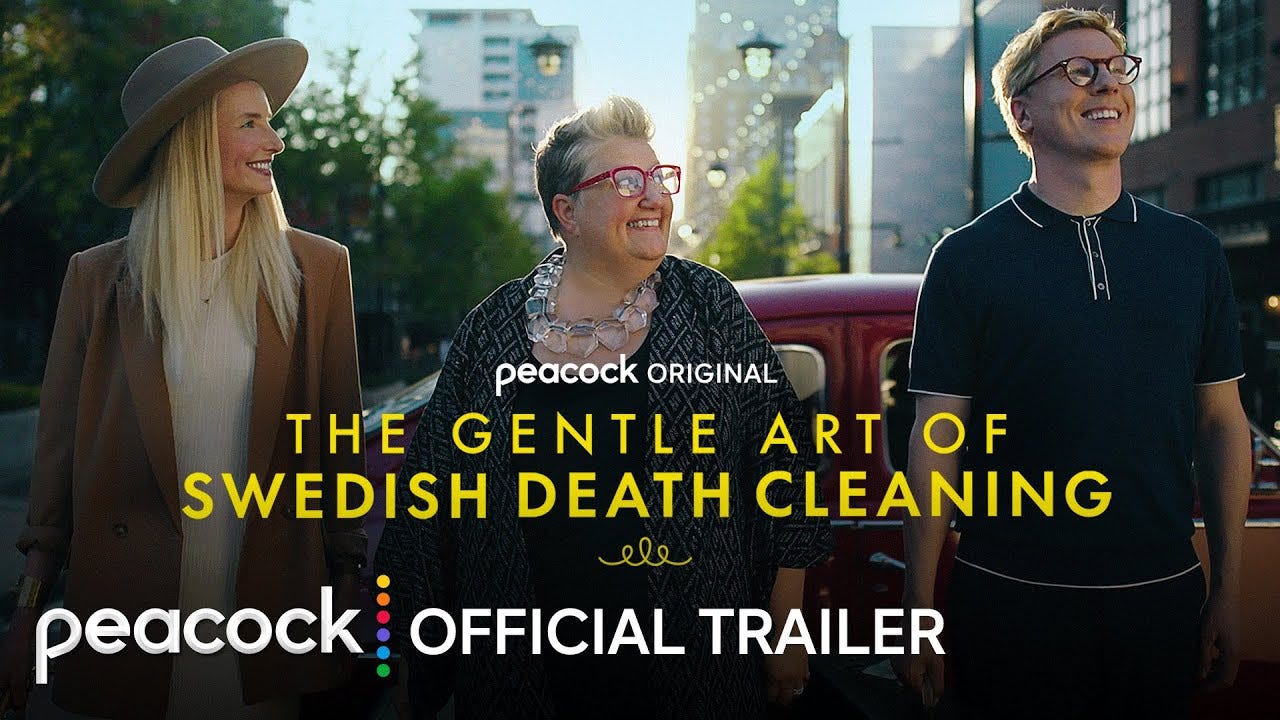Greetings from a week actually spent at home in the Treehouse! I am fresh off one of my favorite events of the year — the Financial Times Weekend Festival. This British-based, salmon-pink newspaper keeps me company every weekend with a wide variety of new ideas in geopolitics, literature, architecture, and more. I began reading this paper when I was a 19-year-old, study-abroad student in London, and 30+ years later I am still nerding out over it.
My favorite part of both the newspaper and the festival is that these Brits — and the significant number of Americans who work for the paper — don’t take themselves too seriously. Remind you of anyone?
On to the post…
Free & paid subscribers receive the exact same weekly content in their inboxes every Saturday morning. (The newsletter, vulnerable, personal, embarrassing stories, book recommendations, and whatever gifs have made me giggle.)
Considering upgrading to help myself and my editor Leona dedicate more time to The Luminist and support our current non-profit of choice: Experience Camps for grieving kids.
I love the moment when acquaintances become friends.
Like when fellow Substacker
sent a love arrow through my heart (and proved how well she already knows me) via a Substack note encouraging me to check out a new show on Peacock: The Gentle Art of Swedish Death Cleaning.Based on a book of the same name by Margaretta Magnusson, the TV show walks participants through “cleaning out [their] crap so others don’t have to when [their] dead,” as described by Amy Poehler, the show’s executive producer and narrator, and one of our go-to gif generators here at The Luminist.
The series is a potluck of my favorite ingredients: European accents, deep conversation, heartfelt connection, swearing… and a lot of laughter intermingled with tears. Like life.
The ‘death cleaners’ are comprised of Swedes — Ella the organizer with her collection of hip, blocky glasses and subversive grin, Johan the designer with his vertically challenged red hair and side-eyes at the camera, and Kat the therapist, exuding warmth under her funky hats and elven locks.
They have mastered not just the art of cleaning and organizing, but also of speaking straight to the heart of the matter — with love. None of this “protecting others’ feelings'' while secretly saving themselves from a hard conversation. They call it as they see it. But with bone-deep compassion that feels like gently descending into a clear pool… rather than getting your hands covered in something sweet and sticky.
And at times the death cleaners are wrapped in a cloud of confusion on American colloquial phrases and stifling emotional claustrophobia. The looks on their faces say, “How can these people be so exuberant but so closed off? So committed to getting the most out of life but so out of touch with their feelings??”
Unsurprisingly, they even say this out loud.
Because it turns out a lot of the reason why we hold on to stuff is because we’re holding on to an emotion — unable or unwilling to let it go — while desperate for the physical and mental spaciousness on the other side.
In Episode 5, “What Lies Beneath”,
the death cleaners train their sights on Godfrey, a 33-year-old sparkling human being and cancer survivor. In 2018, Godfrey lost his dad and his mom within 14 months of each other in the midst of dealing with his own life-threatening diagnosis.
Since then, Godfrey has kept all their possessions (like, all their possessions) stacked in a giant Jenga game in his basement. The death cleaners give this space a tongue-in-cheek name: the grief pit.
After Godfrey’s dear friends make a human assembly line (a factory, as Ella calls it) to empty the grief pit onto the back lawn, Godfrey picks each item up, and, using Ella’s system, sorts out what to keep and what to give away.
After hours of sorting, perseverating, reminiscing, and reflecting… Godfrey resolved to give away… NOTHING.
Ella eyes the camera. “Too much ‘keep’.” She deadpans.
Therapist Kat takes Godfrey into the kitchen for a heart-to-heart. While baking Betty Crocker brownies from a box in memory of his mom, she gently helps Godfrey excavate the reason for the grief pit. Soon he realizes it’s not that he wants to keep everything… He just doesn't want to give away anything. Because that means admitting his parents are really gone.
Tears start to flow. Kat pauses. But Godfrey rushes in, trying to stem the tears with a torrent of words, “I am trying not to cry.”
Kat gently shakes her head.
“You Americans always say that. My Swedish clients never say that. Godfrey, emotions need motion to heal…”
“Can we hug it out, as you Americans say?”
As they lean in for a big bear hug, Kat’s tall frame engulfing his slight build, the oven dings. Godfrey cheekily chimes in, “The brownies are ready! Now we can eat our emotions! Another American thing!”
Kat doesn’t miss a beat, “You are teaching me all these American skills!”
Their tears turn into belly laughter faster than a race car driver shifting gears.
I cried while writing — and reading and editing and talking about —
the last few Luminist posts. Some of you did too. Our social norms say that crying is all we do when we experience loss, because sorrow is all we feel. This undersells our complexity, while also missing the subtle interactions and connections between feelings like grief and joy.
When we try to hold an unpleasant emotion in, it takes up all the space. Joy, gratitude, fulfillment become shells of what they once were because we aren’t able to fully engage with them. We are too busy keeping a lid on what we don’t want to feel. But when sadness, for example, is finally allowed to have its good cry, the next thing it generally wants to do is lay down like a toddler overdue for a nap. Suddenly, the body and psyche aren’t clogged with resistance and tension anymore. They are wide open…
And what so often fills that space once it’s made? Laughter. Lightness. Relief… filling the cracks of your entire being just as the grief once did.
I think of the giggle I had with Connor and Kendall, late on our first day without Mike, over never having to squeegee our showers again. I see myself cackling when Toula presented me with my Despot plaque. I remember countless times, just a few days, weeks, months after Mike died, when the laughter erupted out of me. I don’t remember most of the jokes, just the liberation of it. Reality was still grim, but all the tears I had shed had helped me come to terms with that. And now I was coming to terms with the flip side of the coin — I was still very much alive.
It blows my mind that humans respond over and over again to an emotional “breakdown” by riding a updraft straight into pure delight. Could there be a clearer sign that we’re on the right track?
I think this is the secret handshake the universe has arranged for us to heal. Laughter and tears have the same energy — let them both out. When you cry more, you laugh more.
It worked for Godfrey.
With Kat, Ella, and Johan cheering him on, he slowly but surely sorted through the belongings that were encasing his stalled feelings like cement around a nuclear reactor… and set them all free.
The episode concludes with all Godfrey’s friends coming together for a celebration of his parents’ lives — something Godfrey was unable to do while he was sick. They tell stories. They cry. They laugh. They toast. They hug.
As the death cleaners are preparing to depart, Godfrey shares one more thing.
“[During the celebration], I felt my mother and I could hear her laughter. And how proud she was of me... that I endured.”
There was finally space in Godfrey’s life again, physically and metaphorically, to feel something beyond profound loss. The loss was still there, of course, but suddenly, so was the love.
As the pastor who married Mike and I wrote in a letter after he learned of Mike’s death… “You get to keep the love.”
But you must make the space to see it. To feel it. To live it.
What about you?
While I'm clearly a big fan of liberation through crying (shocking to all those who knew the old me!), it’s not the only means to this end.
What are the other activities, techniques, practices you have found to liberate emotions trapped in your body and mind… and basement? How do you make space for your natural state — expansion, empowerment, hope?
For example, I also love meditation. I do it almost daily. I’ve also heard heavy-metal singing, top-of-the-lungs shouting, and pillow punching can be quite effective. I’m considering adding them to the rotation… if only to save on tissues.
To setting ourselves free,
Sue











Aw, thanks for that, Sue. ❤️ I swear, that show is just magic. You laugh, you cry, you fall in love with Ella (follow her on Instagram if you haven't already). And The Luminist is magic, too. I think we Americans make the mistake of equating the depth of our pain and grief with the depth of the love we had/have for those we lost. I noticed that with breakups in junior high (too young!) and high school, when groups of girls would console sobbing friends (and this would go on waaaay too long). Grown-ups continued that bad habit. We wear grief like a badge of honor, shutting out other emotions, getting angry at people who expect us to move on. I think that's because we (Americans) want to ignore and protect against "bad things" happening (we Nerf playgrounds, FFS), leaving us unprepared. But, as the Swedes will tell us, bad things are a part of life and we need to learn to accept and cope with them, even prepare for them. Then, embrace them and the emotions they bring when they inevitably occur. That's not focusing on the negative (as we wont not to do); that's understanding life. Your good work here shows people how to accept the unthinkable and carry on, discovering the gifts and joys and strength that come from being present in life. Thank you, Sue. And Connor and Kendall. Fika on me the next time you're in L.A. xo